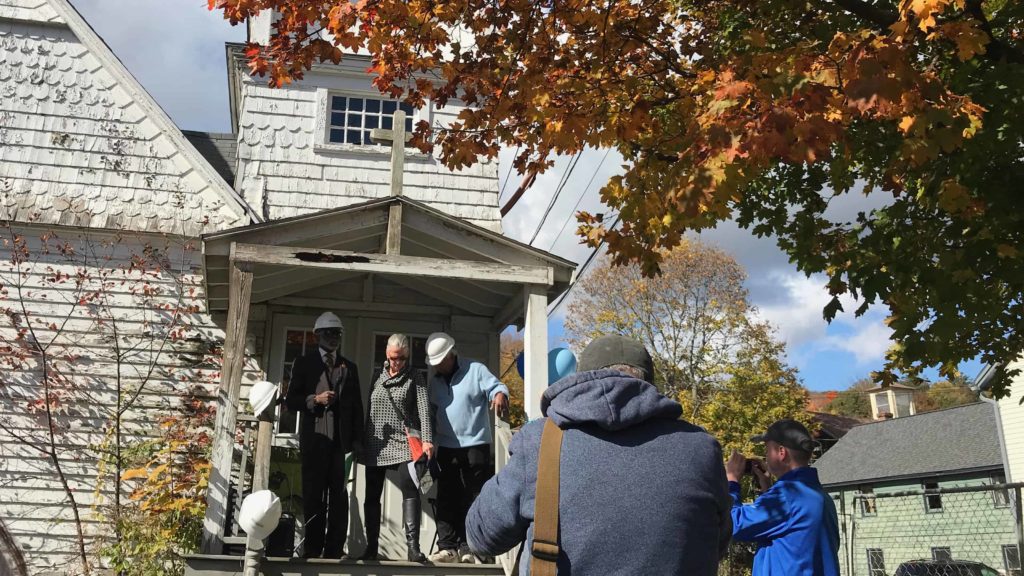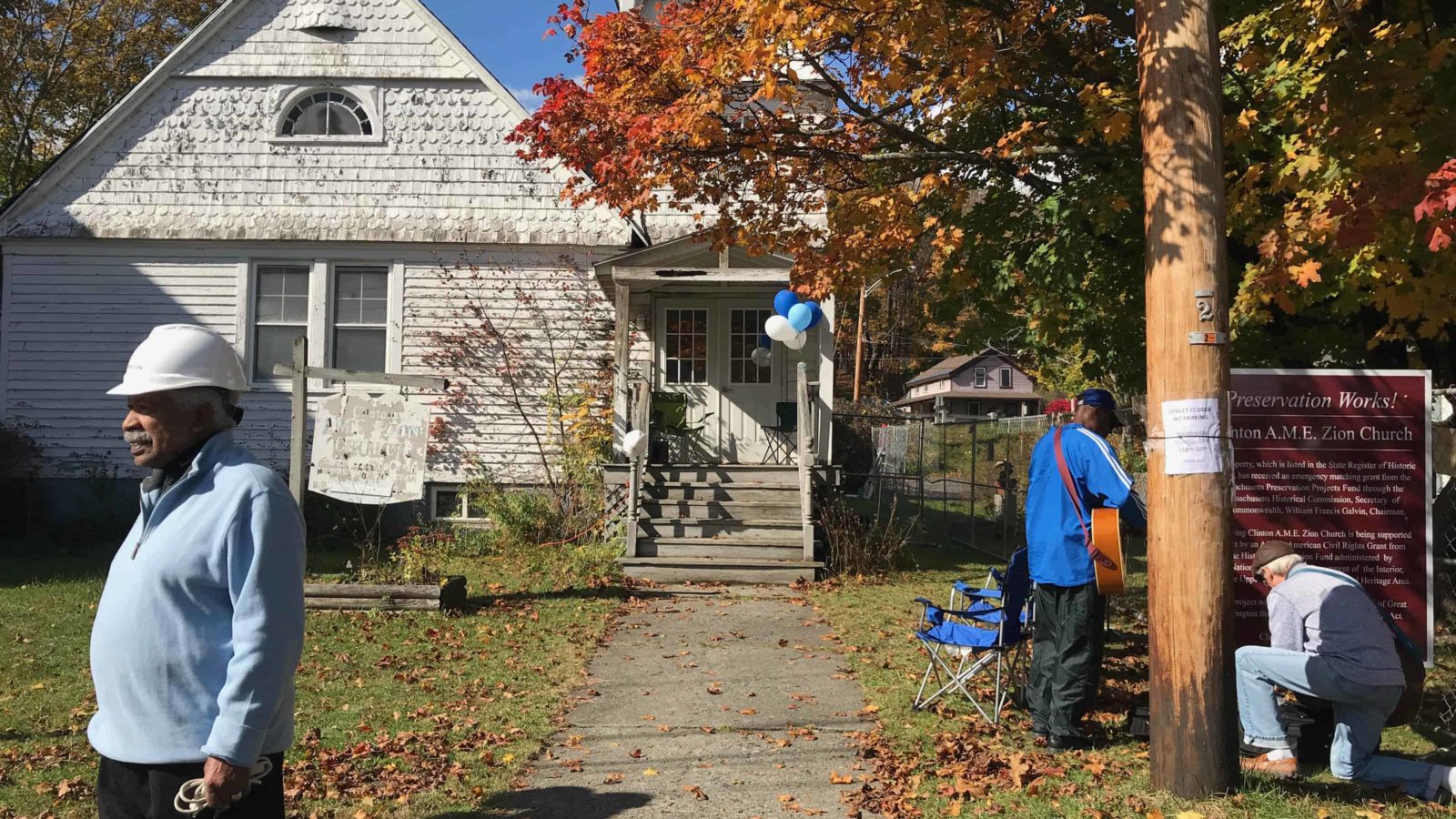In New York City, Mario Gooden, principal architect and founder in the New York firm Huff + Gooden, has designed sunlit buildings, often with transparent and translucent walls, from Los Angeles to Johannesburg. At Columbia University, his colleague Mabel Wilson is designing a memorial in a smooth ring of granite on the UVA campus — it holds the known and unknown names of 5,000 enslaved people who worked here, in a form that recalls a broken shackle and the music of a ring shout. And now they’re looking toward the Berkshires.
Wilson and Gooden are 2019 American Academy of Arts and Letters architecture award winners, as co-directors of the Global Africa Lab at the Graduate School of Architecture at Columbia, which looks closely into the nature of the global African diaspora through design, research, and technology — and this winter, they will turn to Great Barrington and the restoration of the Clinton A.M.E Zion Church.
“We are thrilled to be a part of this project,” Gooden says, standing on the church’s wooden steps on a sunny morning in late fall, as Larochelle Construction, Inc., of South Hadley, begins work on stabilizing the church roof. “This building is not only a part of African-American history — it is a part of American history.”
‘We are thrilled to be a part of this project. This building is not only a part of African-American history — it is a part of American history.’ — Mario Gooden
With work underway to stabilize the historic building, a team of nationally recognized African-American architects and designers are envisioning the historic church as a community center in the 21st century, as it has served an African-American community in the Berkshires since before the revolutionary war.
Walter Hood, creative director and founder of Hood Design in Oakland, California, will join Gooden and Wilson to re-imagine the new center from the outside. As a professor at the University of California, Berkeley, in landscape architecture and urban design, he has won national recognition, including the 2019 Dorothy and Lilian Gish Prize and a 2019 MacArthur fellowship for work like the Broad Museum Plaza in Los Angeles, inviting a walk among 100-year-old olive trees.
He also has designed the landscape of the International African American Museum in Charleston, South Carolina, with a memorial garden and a tidal pool. When the tide ebbs (as the foundation explains in the award), an engraved pattern of men and women will appear in the water as though they are in the hold of a slave ship. Almost 40 percent of the enslaved Africans who came to this country stepped onto the shore there.
Here, along the Housatonic, Gooden and Wilson agree that the Clinton Church, and the history it represents, matter on a national scale. Since 2016, the Clinton Church restoration Inc. has raised almost $1 million to preserve it.

Leaders in the Clinton Church restoration, including Colin Powell, Wray Gunn and Eugenie Sills, gather to announce progress and plans.
The church has become part of a larger movement across the country to understand and preserve black American history, says Eugenie Sills, interim director of the restoration. The building is on the National Register of Historic Places, and the restoration has won support from the National Park Service, among sites like the African Meeting House in Boston and the Langston Hughes House in Harlem.
In the Berkshires, the church is one of 48 historic sites on the African American Heritage Trail honoring local and national figures, including W.E.B. DuBois, the writer, professor and political activist with international influence — he co-founded the NAACP and traveled the world, and his ideas are shaping public conversations a century later.
W.E.B. DuBois in the Berkshires
DuBois was born in Great Barrington. He grew up here, Sills says, as the African-American community grew and the local AME congregation built the Clinton church. His family attened the First Congregational Church then, Sills says, and they had a strong relationship with the Clinton Church community.
At 15 DuBois served with the Clinton Church’s literary society as it hosted visiting performers, book groups and debates on national political and social issues. As a journalist in the 1880s he wrote 30 columns for the New York Globe on his life in Great Barrington, and he often wrote about the Zion Society and community.
It was a place where the black community could teach and take action, DuBois writes. In his later writing, he draws inspiration from the music and language of the black church, and from its history as a gathering point and a source of resistance and transformation.
In The Souls of Black Folk, he describes the black church as the social center of black American life. It could hold “in microcosm all the great world from which the Negro is cut off by color-prejudice and social condition.”
DuBois is part of the draw to create a cultural center in this community, Gooden says, and he feels the pull of the community who built this church. Across a century, they have shaped the community around them and taken a stand in national movements.
He quotes DuBois writing to the NAACP journal the Crisis after World War I — there is nothing more American than African-Americans.
Clinton Church’s local roots
Under the steps at Gooden’s feet, the cornerstone of the church has stood since 1886. Wray Gunn, board chair of the nonprofit and a former church trustee, recalls the church from his childhood. He looks out from his living room in Sheffield toward a local farm and shares warm memories.
It was an active hub of the community through those years, he says. His family lived in Stockbridge then, as they had lived in the Berkshires since Agrippa Hull returned as a veteran of the Revolutionary War. The Gunn family homestead lay on East Main Street, just past the former Berkshire Playhouse, and his father was born there.
Gunn remembers the neighborhood around the church. Black families lived and worked here around Rossiter and High streets. Here were entrepreneurs and local businesses — an inn, a restaurant, a tailor shop, a lumber man. The Rev. Raleigh Dove led the congregation, newly married, with his young family.
“He preached and sang and played the piano,” Gunn says. “He had a powerful voice, and everyone loved him.”
The Gunns would come to Sunday services in the morning, and often they would stay all day. Wray remembers Gospel sings and church dinners serving 80 people or more.
The congregation had held performances since its earliest years, literary evenings and speakers and classes for children. They filled the neighborhood with an energy he hopes to see again — people talking in the chapel and on the steps and under the maple trees.
“Let’s fill the hall up,” he says, “so everyone can enjoy one another.”
A place to teach and take action
That communal energy had a practical and political drive as well. In 1969 the NAACP held meetings here in the Clinton Church basement. Gunn’s father was the president then, and the group led talks about police brutality, hunger and homelessness that led to the founding of Construct Inc., a local nonprofit celebrating its 50th anniversary. The Rev. Esther Dozier carried on as a leader in the community into this century.
“This church … put ideals into action,” Gooden says. “It was important not only in feeding the soul but in feeding the mind and consciousness, and the body.”
He is a Professor of Practice at the Graduate School of Architecture Planning and Preservation of Columbia University, and he has exhibited his work nationally and internationally, as Wilson has. At Columbia they co-direct the Global Africa Lab.
She is a professor of Architecture and in African American and African Diasporic Studies; her Studio & was a competition finalist for the Smithsonian’s National Museum for African American History and Culture, and her book Begin with the Past chronicles the museum’s creation and the stories in its design.
In the Memorial to Enslaved African American Laborers at UVA, she and her team tell stories in stone and water, and the fall of light, and snowdrops on an early spring day.
A water table will recall libations and waterways that served as routes to freedom (the team explains on the memorial’s website). A path will lead in the direction of the North Star and freedom, and another will align with the sunset on March 3, the day when Union troops emancipated the local enslaved people at the end of the Civil War.
This winter she and Hood and Gooden will begin to shape the stories they see in Clinton Church, to give them physical form.
From church to cultural center
Stepping into the old wooden building, Gooden can see the outline of the pews on the walls, years after the pews have gone.
“You can go back decades,” he says, “in the layers of physical fabric that will be uncovered. The building will be part of the design.”
He thinks of the black church in the early 1800s, when it was illegal in this country for black congregations to meet and worship, and so they met in the woods and made bush arbors or brush arbors, shelters of limbs and branches.
“They made a space for themselves for worship, for planning, for political activism,” he says. “It’s no coincidence that the church was key to the Civil Rights Movement. This building bears witness to that history of action.”
A building may hold a perspective or tell a story in the shapes of its spaces and the play of light and shadow, he writes in Dark Space, recaling W.E.B. DuBois’ Souls of Black Folk. Gooden considers a way forward, a new kind of building in a larger project of cultivating black self-awareness.
A new building can shape the experience of the people who come in, as the architect guides the way people walk into a space and move through it, and what they see within and outside — and how it may connect to other places as it opens into a wider world.
***
Great Barrington holds many historic sites relating to W.E.B. DuBois, including his birth site and his boyhood homesite, the cemetery where his wife Nina and his son are buried, the DuBois Center within North Star Rare Books, and the summer home where his friend, the writer James Weldon Johnson, wrote much of God’s Trombones, poems inspired by sermons from the long oral tradition of the black church; Johnson is widely known for the poem Lift Ev’ry Voice, now known as the African American National Anthem. To learn more, visit the African American History Trail.
W.E.B. DuBois’ biographer, David Levinson, who serves on the CCR advisory board, has also chronicled Du Bois’ relationship with the Clinton AME Zion Church in The African American Community in Rural New England.

